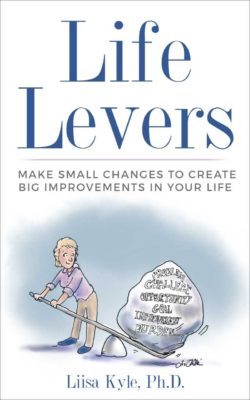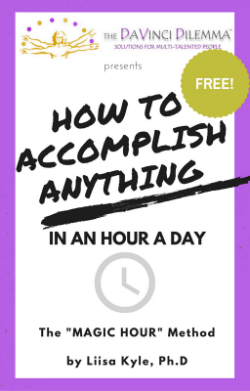It was the beginning of 2010. I was disgusted with myself for not making progress on a screenplay that had been gathering dust for over a year while I spent each day in a whirl of busy work and distractions. Like any DaVinci type, I needed to focus. What was new was, this time, I knew it.
Many people have heard of a writers’ and artists’ retreats where a group of like-minded souls gets away from it all, spend a lot of each day doing their writing or art, and part of it socializing, commiserating and possibly drinking. I’d been on a great one in Italy the summer of 2003 with my mentor, UCLA professor Lew Hunter, author of Screenwriting 434. In 10 sweltering days, I’d picked a concept, written a logline and outline, and got a staggering (for me) 50 pages written while spending a lot of time lying by the pool drinking local wine. I loved bouncing my ideas off of my fellow writers, and helping them with their stories.
Going it alone
But this time, I didn’t way to wait for someone else to stage an event, and I wanted zero distractions. It was long since time to stop bouncing ideas and start getting them on paper. So I decided to go off on a writer’s retreat all by myself. I remembered a time-share week my husband and I had not managed to use and traded it in for a week in a condo in Sedona, AZ, about a seven-hour drive from my home in San Diego. Total cost, including gas and groceries, about $400.
So what happened that week on my solo retreat? I laughed, I cried, I wore no makeup and mismatched socks. And while I didn’t finish the script, I did get 80 pages written. Some were crap, some were great, and I’m still not sure which were which, but it was a big accomplishment. Over the next two posts on this, I’m going to share what I learned from the experience and tips on how to design and get the most out of your own solo retreat.
What to expect on a solo retreat
You will have some “splainin’ ” to do. First, to your significant other if you have one. My husband was very understanding because we both work from home, and he knows all too well that we distract each other all day long. I think he was looking forward to getting some things done himself in my absence. But then there was the rest of my family and my friends. “Is everything all right?” they asked, fearing for my marriage, my sanity or both. The lady who checked me in at the time share asked if my husband or anyone else would be joining me, and peered at me suspiciously. I thought I even detected some hope among some single friends that I might soon be rejoining their ranks. I discovered that in our society, for some reason, wanting to be alone when you don’t have to be can make you appear broken, crazy, or up to no good. Be prepared that a lot of folks won’t get it, and don’t let their worries – or misplaced schadenfreude – get to you.
You have to learn to be with yourself. I was used to — OK, addicted to — constant distractions and outside stimulation, and here I was, with no phone calls until 6pm, no internet, no TV at all except watching movies on DVD (for homework only), and no reading besides reference books on screenwriting and movies. Anyone who has read The Artist’s Way may remember the Reading Deprivation exercise in week four. When I did it, I couldn’t stand the sound of my own voice in my head, or even the silence on the few moments when that voice shut up. But on my solo retreat, with no alternatives, I learned to make peace with, and even enjoy, my own company…even if it took a day or two.
You reconnect with what you love. Like a romantic getaway with a loved one, alone time with your talent and creativity allows you to rediscover and celebrate what made you want to pursue the thing in the first place. With nothing else on the agenda, you have time to focus on and experience the inspiration and the pleasure of doing the thing, rather than only the guilt of not doing it or the stress trying to fit it in. With nothing else to do, you can relax and enjoy.
You start to notice your rhythm and your courage. Of course, it’s not all hearts and flowers. You have to stick around long enough in the silence and dread with no distractions, to notice what’s really going on. I saw a pattern, an ebb and flow. I had one really Bad Day where nothing worked, I got very little done and I was sure the script was a failure. I whined to my coach and my husband that night, and went to bed. I only knew one thing, and that was I Sucked.
The next day was inexplicably great. I wrote 12 pages effortlessly before breakfast and treated myself to a long hike and a new silver necklace. I couldn’t believe it, and there didn’t seem to be any reason for the change, except that I had kept showing up. Being forced to stick with something that’s hard brings up strength and resilience you may not realize you had. At home, I would have bolted, taking refuge in ice cream or re-runs of What Not To Wear on TLC. Pushing through my fear and upset showed me I could do it, and that it wasn’t even really THAT hard. And what they say about a good night’s sleep is true. Even the worst things really do look better the next morning.
You discover the peace of doing just one thing at a time. With multi-tasking not an option, you don’t have to feel guilty “just” doing one thing. It was such a gift for a DaVinci like me to have the space and permission to completely lose myself in one activity for extended periods. And I even extended this to my leisure time. When I was walking in the mountains, I didn’t talk on the phone. When I was talking to my husband or my coach, I didn’t have one eye on the TV or my email. I realized to my shock how much I enjoyed doing only one thing — and how seldom I actually did in “real” life. No wonder I was always exhausted.
Your time becomes super-valuable. At home, I put things off. Thinking—mistakenly—that I had all the time in the world made me waste gobs of it on things that really were not worth it, like personal drama and YouTube. But knowing my retreat time was limited made me guard it like a jealous mama bear. The one time I had to go on the internet to put out a fire for a client, I set a timer for an hour so that would be all I gave up. The limit on your time also makes it endurable. No matter how hard what you are doing is, knowing you only “have” to do it for a weekend or a week makes it easier to stay on task.
In the next post on this topic, I’ll give you hints on how to plan and get the most out of your solo retreat.
Activity: What would a solo retreat do for you? List possible projects you might tackle and what results you would want. These results can be tangible (the first draft of your novel), emotional (reconnect with your identity as a creative person) or both.
Have you benefited from “alone time”? Please share your thoughts below.
*****
If you’d like to share or publish this article, you may, if you include the author’s name, a link to this original post and the following text blurb:
Are you struggling with too many talents, skills, ideas? You may have The Da Vinci Dilemma™! Find tools, fun quizzes, coaching, inspiration and solutions for multi-talented people at http://www.davincidilemma.com/.



